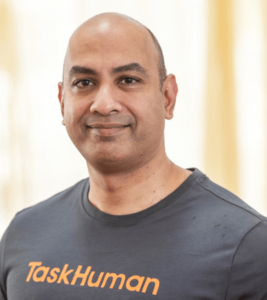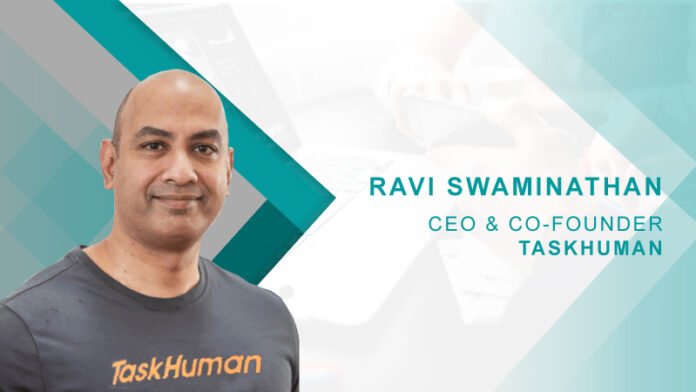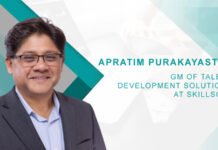Ravi Swaminathan sheds light on TaskHuman’s work culture, leadership platform, and the way great resignation has impacted HR-Tech. He also talks about strategies to upskill and reskill talent.
1. Can you give us a brief of your career before TaskHuman?
Before TaskHuman, I spent about two decades in tech focusing on a range of areas including programming, program management, product marketing, segment marketing, corporate strategy, sales operations and P&L management, and more at various tech companies including Ericsson, Dell, Motorola (Freescale), and SanDisk. Most recently before working in the startup world, I was a VP and GM at SanDisk, where I helped conceive and create a brand new product division for a large-scale enterprise storage system built around flash memory and grew the team from scratch to hundreds of people
2. Could you tell us more about TaskHuman and what was the inspiration behind starting this company?
The idea of TaskHuman started long before it was incorporated in 2017, and the app was built and launched in app stores in September 2018. The problem that existed is that no amount of generic articles or watching pre-recorded videos replaced a real person with experience in that area. Creating TaskHuman was our response to solve just that.
TaskHuman organizes the world’s human expertise and makes it instantly available to you via video call. We started by offering foundational needs, including health and wellness, physical fitness, mental, spiritual, emotional well-being, and more. Since then, we’ve continued to expand and support the entire needs of an individual for personal and professional growth, like financial well-being, sales and leadership coaching, pet training, travel planning, and nearly 1,000 other aspects of daily life. Our goal is to help billions of people discover, connect and help each other 1:1 via video call.
3. TaskHuman added Leadership Coaching to its Platform. Could give us a rundown on its significance? How is the response so far and what are some of the new additions users should look forward to?
We launched a Leadership Coaching program to amplify employees’ potential and make training and talent development accessible across the organization.
The program allows talent development and HR leaders to deliver personalized training and guidance at scale from a global community of experts, covering nearly 1,000 aspects of daily work and personal life.
The new platform enhances existing curriculum, initiatives and training plans with unlimited, year-round 1:1 coaching and group sessions with over 125 leadership and development topics aligned to key subject and functional areas, and content authored by our community of coaches.
For companies without an internal curriculum, we offer guided user journeys such as Leadership Foundations, DEIB coaching, and more, all tailored to the multiple needs of different leadership cohorts such as first-line managers, middle management and more.
4. What role does technology play in employee well-being? How is TaskHuman helping the situation?
We’re starting to see more that corporate board of directors are feeling the lack of consideration into employee well-being as a substantial threat to the sustainability of the enterprise. To show the commitment and value of supporting each employee’s well-being goals, employers need to go the extra mile to prove that they value well-being and provide the resources to accomplish these necessities.
To do so, organizations must turn to more holistic employee benefits. This means covering not just the traditional “benefits” for when people fall ill, but also an integrated, preventive, well-being plan for every employee. This should include other key areas of personal growth and holistic well-being such as physical fitness, mental well-being, leadership coaching, and more to cover multiple aspects of an employee’s work and personal life.
TaskHuman provides an app that helps users instantly discover and connect with a global network of specialists covering nearly 1000 aspects of daily life to meet personal and professional goals.
5. How do you think HR-tech can help employers combat the Great Resignation and the global pandemic?
Organizations looking to beat the resignation culture should incorporate a personal and professional coaching solution that integrates common enterprise well-being strategies — such as an employee assistance program, nutrition management, therapy, and financial coaching — with other key areas for personal growth that include holistic well-being exploration, leadership coaching, and more.
Utilizing all-inclusive well-being solutions within your company’s employee benefits offerings ensures you show your entire workforce that you value their time and physical and emotional well-being, not just the work they produce for the business.
These benefits attract and retain top talent, provide accessibility for global workforces, reduce turnover costs with flexible work-life balance solutions, and support the whole individual through comprehensive well-being networks to provide ongoing coaching, support, and growth opportunities.
6. Why are upskilling and reskilling employees so important? What are some strategies that HR professionals can apply to the existing employment scenario?
While the pandemic is partly to blame for mass resignations, it’s a problem that has been brewing for some time. The rapid change to the workplace, coupled with a declining population growth rate, and other factors—like burnout—have created a critical talent shortage.
Companies essentially have two options: Pay more for new employees or invest in the workers they already have through upskilling (teaching them additional skills) or reskilling (teaching them a completely new skill).
But upskilling and reskilling are about much more than just profitability. They’re about investing in employees, creating new opportunities, and showing workers they are valued. When it comes down to it, every company should be thinking about ways to enrich the lives and careers of its employees.
7. What is your take on the modern workforce? What do you prefer – On-site, remote, or hybrid? Why?
As companies grow and adapt to the changing landscapes, they also must change how they best support their workforce’s work-life integration. By offering fully remote work, you acknowledge that you trust your team and acknowledge they can perform their roles in a fully integrated way with their daily lives. The joy of remote life allows teams to be more diverse, with a richer culture.
8. How should companies go about measuring employee performance and productivity? What is the work culture at TaskHuman like?
At TaskHuman, being a completely remote team by design (nothing to do with COVID – we were always fully remote), we tend to measure productivity based on how well employees do when they are present. It’s not about what hours employees work because that’s totally up to the employee but how well employees do relative to goals and timelines that they set for themselves relative to project plans.
9. How have you seen the workforce wellness space evolve over the last few years? Any advice for leaders as they look forward to strengthening their well-being strategy?
We find ourselves in another time of change that is forcing organizations to rethink their approach to employee care. The pandemic has radically altered our societal, professional, and family lives. People’s priorities and needs have shifted. The very nature of one’s professional career is different.
Here are a few of my top forward-thinking tips for companies and HR leaders to embrace a fresh, holistic approach to employee care:
1. Encourage Work and Life Integration — and mean it.
Give your employees the flexibility to work in a way that works best and aligns with their personal lives, and you’ll see a much happier and more productive team. Nobody needs to feel bad about posting on Slack that they are taking a personal hour while working from home, just like it’s acceptable to take a personal call while in the office.
2. Embrace shared experiences between employees despite meeting in person less.
Encourage more shared experiences between employees despite the shift in remote work and meeting in person less. Software technologies like Slack, Zoom, Microsoft Teams and others will help every employee feel like they are equally part of the action and remove distance or location of the team as a critical factor to team success. Shared experiences in both work and personal life via software tools will lead to better team success.
3. Lean into employee benefits highlighting personal well-being and preventive care
With the consumerization of employee benefits, organizations will want to prioritize more focus on personal well-being and preventive care for employees via easily accessible consumer-driven apps/tools. This will help drive better work-life integration, retain talent, and boost overall employee well-being.
10. What motivates you to get up every morning? What do you take pride in when it comes to your company?
I am motivated by the lives we have changed by way of offering coaching in personal and professional areas as well as the lives we have changed to the coaches on the platform. The stories the team and I hear from our community fuels us to continue to expand our platform to support 3 billion worldwide users. From helping people lose weight, supporting families who have lost a loved one, guiding users in their professional growth, or creating revenue opportunities for a global coaching community, the human connections that are made day in and day out are what inspire the entire TaskHuman team.

Ravi Swaminathan CEO & Co-Founder, TaskHuman
Ravi Swaminathan is a seasoned technology executive, wildly passionate about creating products with social impact that can change the world for the better. He drives the TaskHuman vision forward every day.












